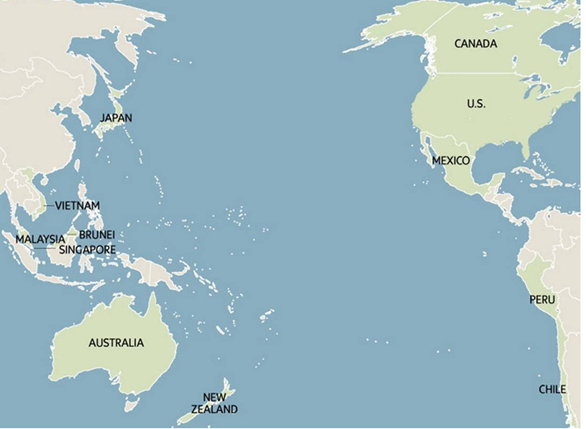Written by: Angela Parkin and Brad Lehigh, GTM Governance
On October 5, 2015 after seven years of negotiations, the twelve countries making up the Trans-Pacific Partnership (TPP) concluded their negotiations for a free trade deal. The twelve countries that make up the TPP are Australia, Brunei, Canada, Chile, Japan, Malaysia, Mexico, New Zealand, Peru, Singapore, the United States and Vietnam. The TPP agreement covers 40% of the global trade with a market of nearly 800 million people and a gross domestic product (GDP) of $28.5 trillion.
The TPP is the biggest trade agreement since the creation of the World Trade Organization (WTO). Although it still has some major steps ahead of it such as being legally scrubbed, translated and ratified by each country. Implementation is expected to take place in eighteen months to two years. While it is unlikely any country will fail to ratify the agreement, the ratification process in some countries will be challenging.
According to the text of the TPP, there are three options for how the agreement may come into force:
- All parties complete necessary domestic procedures within two years after the initial signing. Once complete, the agreement is in force 60-days afterward.
- At least six of the original parties, accounting for 85% of the region’s gross domestic product (GDP) in 2013, complete their domestic process for implementation. Once complete, the agreement is in force 26 months after the initial signing of the TPP.
- Assuming the agreement did not come into force under the first two options – no set timeline, but when at least six countries meet the 85% regional GDP, then the agreement is in force 60-days afterward.
Six nations that account for 85% of the 12-member nations’ GDP are required to ratify the agreement in order to move TPP into force. With these requirements, it means that the United States and Japan – which make up a combined 77% of the GDP of the 12 signatories – must ratify the agreement along with at least four others that make up the required remaining 8% GDP.
With the release of the text, some information has become available, for example:
- The U.S. stated that the 12 parties have agreed on a single set of rules of origin that define whether a particular good is “originating” and therefore eligible to receive the TPP preferential tariff benefits. The product-specific rules of origin are attached to the text of the Agreement. The TPP provides for “accumulation” so that, in general, inputs from one TPP party are treated the same as materials from any other TPP party, if used to produce a product in any TPP party.
- Canada stated that 45% of a vehicle’s content must be of Canadian-origin in order to qualify under the TPP. This is a change from the North American free-trade agreement (NAFTA), which established that 62.5% of a vehicle’s content must be originating. Canada also stated that the current 6.1% duty rate will be phased out over 5 years, whereas the current U.S. 2.5% duty rate will be phased out over a 25-year period for originating goods. Some seafood will be immediately duty free, with some processed seafood having a 10-year phase out.
- Japan is a key opportunity for TPP members as they will immediately eliminate the 32% duty rate on 90% of their agricultural products. Canadian beef and pork producers are among the big winners under the TPP deal as within 10 years, Japan is promising to eliminate its tariffs on a wide range of pork products, while the current 50% tariffs on beef will be reduced to 9% within 15 years. Vietnam will move quicker, eliminating tariffs of up to 31% on fresh and frozen beef within two years.
Once ratified, the TPP will coexist with the North America Free trade Agreement (NAFTA) for a few years as the NAFTA agreement may offer greater benefits over the TPP. However, the benefits for TPP cannot be under estimated for its members as new export markets open up.
